Display, Case and Peripherals
We have covered the core components for all of the systems, so now you need a box to put everything in, a power supply to get everything running, as well as a display, speakers, keyboard, and mouse. If you already have a decent computer system, you might want to reuse some of your existing parts, but it might be easier to simply buy a new case and power supply so that you can sell off your old system (or add a second full computer as the case may be). We have four configurations for you to choose from, ranging from an upper midrange selection all the way up through the no holds barred ultra high-end setup. While all four could be used with any of the computer systems listed in this guide, the higher-end parts you choose for your main components the more you should probably spend on the remainder of the system. Of course, you do not need to use all of the choices from one table; if you want to get an ultra high-end display but use baseline components for the rest of your system, there's nothing stopping you from doing so. Mix and match as you see fit!
| Base High-End Case and Accessories |
| Display |
Acer AL2216Wbd 22" 5ms 1680x1050 |
$339 |
| Case |
Antec Solution SLK3000-B |
$52 |
| Power Supply |
Seasonic S12-500 500W |
$113 |
| Keyboard and Mouse |
Microsoft Comfort Curve 2000 with Optical Mouse |
$28 |
| Speakers |
Logitech X-530 5.1 |
$55 |
| Total |
$587 |
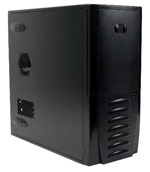 |
Our baseline recommendation has many similarities with the upgraded midrange configuration we used in our last buyers guide, including the use of the same 22" widescreen display from Acer and the Microsoft keyboard and mouse combo package. We have chosen a slightly different case and power supply, although the choice of case is going to be largely based on personal preference. The Antec SLK-3000 case is your classic steel Antec chassis with a black paint job: it's durable, easy to work with, and it includes a reasonably quiet rear 120mm fan with an additional 120mm fan mount at the front of the case. A second fan isn't absolutely required, but adding a lower RPM fan can help ensure that your components stay cool. As we are using multiple graphics cards in all the configurations, we felt a good-quality power supply was a required starting point. While just about any 500W or higher rated PSU is going to be sufficient, we wanted something relatively quiet that we were confident would last a long time.
(Ed: And we changed from the original PSU choice due to user feedback...) We selected the Seasonic S12-500 to go with the Antec case, as Seasonic is one of the most highly regarded PSU manufacturers around. 500W might seem low to some, but this is truly a 500W PSU with a high efficiency; it can really output 500W to all the peripherals - more than enough for the systems listed here today - and it will do so without drawing substantially more power from the outlet. We also added some basic 5.1 speakers from Logitech - something we omitted in the previous buyers guide.
(Ed: Sorry!) For the basic builds, we feel most users will be fine using integrated audio, so we are not listing a sound card, but you can see some options below.
| Upgraded High-End Case and Accessories |
| Display |
Acer 24" AL2416Wd 6ms 1920x1200 |
$686 |
| Case |
LIAN LI PC-7B plus II |
$100 |
| Power Supply |
OCZ GameXStream OCZ700GXSSLI 700W |
$130 |
| Keyboard and Mouse |
Logitech Keyboard and Mouse - Wireless + Rechargeable |
$56 |
| Sound Card |
Bluegears b-Enspirer |
$106 |
| Speakers |
Cyber Acoustics A-5640rb 5.1 |
$100 |
| Total |
$1178 |
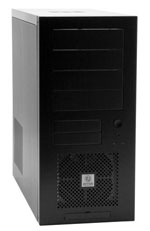 |
Stepping up one notch, we've moved up to a 24" LCD from Acer, sporting a native 1920x1200 resolution with a fast 6ms response time. With all the money spent on upgraded graphics cards, there's no point in not having a high-end display to help keep them busy! For the case, we chose the Lian Li PC-7B black aluminum enclosure. Lian Li has always been known for building high-quality cases, and this is no exception. Like the Antec we selected above, it includes two 120mm fan mounts at the front and rear of the case, only this time both fans are included. We upgraded the power supply one more notch to a 700W model, this time going with the OCZ GameXStream 700W as it is presently the lowest priced quality 700W PSU available. Thermaltake, Fotron Source, and several other manufacturers offer similar power supplies - in fact, most of these power supplies are simply tweaked Fotron Source designs, so if you can find one of those for less money there's little difference other than the name on the side of the PSU. For the input devices, we switched to a wireless Logitech keyboard and mouse, with the mouse including a recharging stand. Some people have other preferences as far as keyboards and mice go, so get what you're comfortable with.
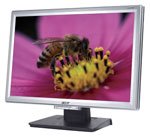 |
We've also upgraded the speakers, and we added a Bluegears b-Enspirer soundcard. A lot of you may not have heard of this soundcard yet, but it is definitely one to consider. It uses the new C-Media Oxygen HD CMI8788 audio chip and features real-time Dolby Digital and DTS encoding support. This is a great soundcard for anyone looking to put together an HTPC system, or anyone looking for better than integrated audio without the Creative Labs name. Feel free to upgrade the speakers to something better or use your home stereo system in order to take full advantage of this soundcard. If you're primarily concerned with gaming audio, the Sound Blaster X-Fi is still the better choice, but for light gaming and home theater use the Bluegears b-Enspirer is an excellent alternative.
| Upgraded #2 High-End Case and Accessories |
| Display |
Dell 2407WFP 24" 6ms GTG 1920x1200 |
$720 |
| Case |
Antec Performance I P180 |
$125 |
| Power Supply |
OCZ GameXStream OCZ700GXSSLI 700W |
$130 |
| Keyboard and Mouse |
Logitech MX3000 Wireless + Laser Mouse |
$63 |
| Sound Card |
Creative X-Fi XtremeMusic |
$114 |
| Speakers |
Logitech Z-5300e 5.1 |
$139 |
| Total |
$1291 |
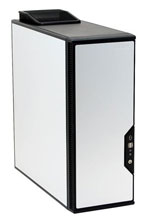 |
Most of the differences between this upgraded version and the previous upgraded version are slight. We've chosen the Dell 2407WFP 24" LCD, which we think looks a little bit nicer than the Acer, and it also includes a better stand and an integrated flash card reader. Are any of those changes required? No, but some of you will prefer the Dell display, and if you wait you might actually be able to find it for less money when Dell puts on one of their classic sales. We changed the case to an Antec P180, going for silver this time because not everyone likes black. (Make sure you get an appropriate optical drive faceplate if you choose this case!) The power supply remains the same, while we ditched the rechargeable wireless mouse for a wireless laser mouse. Finally, we upgraded the speakers another step to the Logitech Z-5300e. A little bit more money, a little bit better sound quality. We also chose a more gaming-centric sound card in the Creative Sound Blaster X-Fi XtremeMusic, which we would assume all of you are familiar with by now.
| Ultra High-End Case and Accessories |
| Display |
Dell 3007WFP 30" 11ms GTG 2560x1600 |
$1450 |
| Case |
Cooler Master Stacker 830 |
$243 |
| CPU Cooling |
Scythe Infinity |
$60 |
| Power Supply |
SilverStone SST-ST85ZF 850W |
$279 |
| Keyboard |
Microsoft Natural 4000 |
$43 |
| Mouse |
Logitech MX Revolution |
$90 |
| Sound Card |
Creative X-Fi Platinum |
$175 |
| Speakers |
Logitech Z-5500D 5.1 Digital Speakers |
$223 |
| Total |
$2563 |
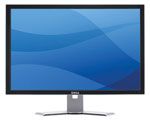 |
The Ultra accessories package is a great complement to the ultra high-end Intel configuration. In a similar fashion, we have maxed out just about every component, sometimes at significant expense. We have chosen the Cooler Master Stacker 830 for our top configuration, as it has a spacious interior and an attractive and easy to use design that's suitable for even the most high-end configurations. Yes, you could buy a different case, and as we often state what case is "best" is largely a matter of personal preference. For the display, the best computer deserves the best LCD currently available, so we have selected the Dell 3007WFP 30" LCD with a native 2560x1600 resolution (or WQXGA if you prefer). Definitely don't skimp on your GPU selection if you choose to go with this large monitor and plan on gaming at the native resolution!
We also jumped up to an 850W power supply from Silverstone, which costs almost twice as much as the 700W OCZ.
(Ouch!) However, with rumors circulating that the next generation high-end graphics cards from NVIDIA and ATI will
require even more power than the current models, we felt that any ultra high-end system needed a power supply equal to the task. (You could jump up to a PC Power & Cooling Turbo-Cool 1000W PSU if you really want to go extreme, but be prepared to fork over nearly $500 for the privilege!) The soundcard has been bumped up to the platinum edition of the X-Fi, which adds a 5.25" bay that provides front panel connections but is otherwise the same as the other X-Fi cards. For the speakers, we moved up to the Logitech Z-5500 digital speakers, eliminating the interference that can be generated by all of the electronic noise inside your computer case. Finally, for the user interface we went with Microsoft's Natural 4000 keyboard and coupled that with
Logitech's Revolution MX mouse, both of which are arguably best in class peripherals. However, personal preference still plays a role, so you might want to try out these devices in person at your local computer store.
CPU Cooling
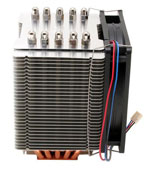 |
One item that we added to the ultra configuration that is worth considering for any of the system builds is an aftermarket heatsink to help keep your processor cool. If you are looking for the HSF that we currently feel is the best air cooling available, look no further than the Scythe Infinity. It is absolutely massive and definitely won't fit in every computer case out there - or on every motherboard - but if you are serious about overclocking then the $65 is money well spent. Another good alternative is the Tuniq Tower 120, which is unfortunately out of stock everywhere right now. We consider the Scythe Infinity to be the better CPU cooler, but the Tuniq Tower 120 is very good and might cost a bit less. Another competing solution (that's just as large as the Infinity) is the Thermalright Ultra-120, which typically equals the other two in cooling prowess and may cost a bit more or less depending on where you find it. For cases and motherboards that aren't quite as spacious, Zalman and Thermalright offer reasonably priced CPU coolers that will still outperform the stock heatsinks from both AMD and Intel.

















45 Comments
View All Comments
JarredWalton - Monday, October 9, 2006 - link
Try configuring a similarly equipped "ultra" system at any of the vendors you mentioned for $5500 - including a 30" LCD, remember, plus speakers and all the other stuff. Note that all prices include shipping to the continental US (although tax is not included). Sure, you get support from one location, but we're not here to constantly recommend system vendors.There's a huge DIY audience that reads AnandTech, and at least this gives people a baseline price list that they can look at when they're considering pre-built systems. We try to cater to all markets, not just the vendors that buy advertising.
Powersupply - Monday, October 9, 2006 - link
As always someone has to be the annoying person who feels this or that is missing. Today it is me.1. I can't see why Thermalright Ultra-120 should be missing from the selection of CPU coolers. It performs on par or better than the Infinity with the same fan.
2. Why not putting more than 2 harddrives into the "Ultra High-End Platform"? After all you went with a stacker case who got plenty of space. 2 x Raptor + 2 x Other HDD would be sweet.
JarredWalton - Monday, October 9, 2006 - link
Added mention of the Thermalright. As for the HDDs, I quote from the original text:I believe that fully covers your second comment, right? It's always an option, but it's not required by any means.
yacoub - Monday, October 9, 2006 - link
The Antec P150 is such a superb case I can't believe it does not many any of your four case recommendations. It is an ideal case in that it is built for quietness, airflow, ease of cleaning, and ease of access. Everything about it is pretty much perfect AND it's not upside-down like the more "popular" Antec P180 case, nor does it have a silly topvent. It's also a little more reasonably-sized (I don't know of anyone building a gaming PC that needs more than 2-3 5.25" bay drives nor room for more than 3-4 hard drives. Really, this case has it all. It's probably the one part of my current build I'm most satisfied with and have been since purchase, which was when they first came out about a year ago.JarredWalton - Monday, October 9, 2006 - link
Some people love the P180, others love the P150, and still others think the ASUS plastic monstrosity is the coolest looking case ever. I figured with a choice of the SLK-3000 and P180, I needed someone other than Antec to represent the case section. :)